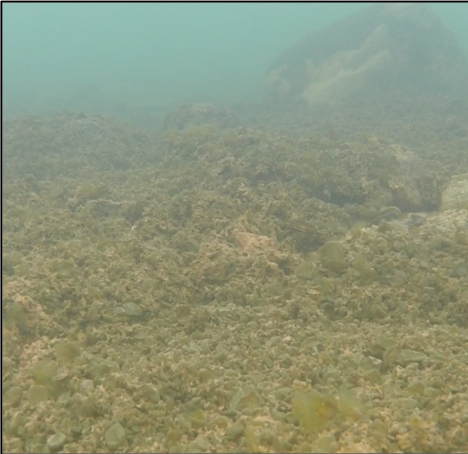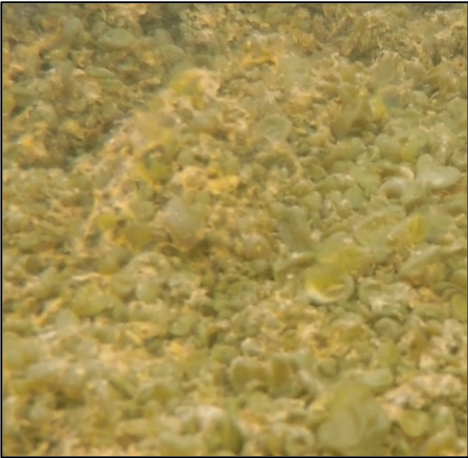


The open water lake margins or “moats” surrounding the lakes are highly dynamic and are a nexus of interaction with other habitats: connecting with inundated soils, interfacing and exchanging with the atmosphere, and mixing with stream inflows, and the under-ice lake water column. The moat systems are also one of the most rapidly changing habitats in the MDV. As lake levels have risen, moat water has inundated soils and the areal extent of the moats has grown in response. Adding to the dynamism of moat expansion, the moats undergo dramatic annual, and at times daily, cycles of complete freezing of the entire moat water column and complete water column thawing. Valley basin morphology has constrained where and how moats have changed over time, as well as the likelihood and extent of connectivity and interactions between the moat systems and under-ice water column. The dramatic and remarkably rapid changes induced by rising lake levels combined with the complex and varied ecological interactions influenced by these habitat transformations, highlight the need to establish a strong baseline foundational record of moat ecology. Our new focus on the moat habitats will address H1 and H2 by examining how moats and their freeze-thaw cycles act as regulators and integrators of landscape connectivity and how moat metabolism and biogeochemistry may reduce legacy controls of production.
The Soil-Lake Inundation Moat Experiment (SLIME) is an interdisciplinary, integrative ecological assessment of the rapidly changing lake margins and expanding lake moats to determine how these changes are altering the ecology of the MCM. In essence, SLIME is a long-term natural experiment that will allow us to monitor the ecological connections and biogeophysical properties across aquatic-terrestrial interfaces as lake levels rise over the course of the experiment. Over the last two seasons, we established permanent sampling transects that span from the under-ice lake water column and benthos through various depths of the moat onto the wetted hydrological margins of the lake, into dry soils at multiple positions on the north and south shores of Lakes Fryxell and Bonney. By continuing to monitor these ecological
parameters at fixed sites along the permanent transect we will quantify the intensity and magnitude of changes as soils become inundated and transform into moats. Our long-term lake level record allows us to determine the approximate time since inundation for each depth along the SLIME moat transects providing a remarkably unique look back into the colonization and establishment of benthic microbial mats in the moats through time. We began monitoring the physical characteristics, biogeochemistry, benthic and planktonic microbial community structure and function, as well as animal community and abundance in the Lake Fryxell in 2017/18 and Lake Bonney in 2018/19.
To understand the timing and cycling of moat freeze-thaw dynamics, physical properties such as moat depth and ice thickness through time were measured and sensors at each transect throughout the entire year. Our preliminary efforts to monitor the physical processes at play regulating moat freeze-thaw cycling have demonstrated that as summer begins, melting occurs not at the extreme margins of the lake ice, but rather, under the moat ice which forms a lens of liquid water between the lake bottom and the surface ice. An implication of this finding is that microbial mats in the moat system may have a longer growing season than the presence of moat surface ice would indicate.
Benthic microbial mat and underlying sediments samples from the moats were collected through the ice with modified piston cores or via SCUBA/snorkel divers at depth intervals of ~0.25m. Photographic surveys were conducted to assess how microbial mat areal coverage and community structure varied with depth. The benthic chemistry and algal biomass datasets are still being compiled, but qualitatively, the abundance and density of biomass observed in the moat systems of both lakes was significant compared to the planktonic or soil communities. Image analysis of the photography transects revealed that each lake moat exhibited 100% areal coverage. Mat thicknesses between 0.5 and 4 cm were observed and biomass abundance appeared to increase with depth in the moats in both lakes. Most remarkably, the benthic microbial mats found at shallow 0.25 m depths in each moat were well established, cohesive and rich in biomass considering that these areas had only been inundated for 2 to 4 years! Mat community taxa was variable with depth and diversity appeared to decline with depth in Lake Fryxell. Lake Bonney mat community structure was invariant with depth and a nearly homogenous coverage of Phormidium sp. was observed (Fig. 37). Nostoc spp. was found in high abundances in Lake Fryxell moats, whereas in Lake Bonney Nostoc spp. was nearly absent, with only rare small nodules observed.
The under-ice benthic microbial mats have been shown to be major contributors to whole-lake biogeochemical processes (Morehead et al. 2005). Like in the moats, the under-ice benthic mats were ubiquitous throughout the photic zone of each lake. The mats form unique and beautiful morphologies as they grow towards the surface light. These mats appeared to be a monoculture of Phormidium sp., however there were distinct patterns of morphological features related to depth.
Moat and under-ice phytoplankton communities were distinct between the two study sites. Lake Bonney was dominated by chlorophytes, with minor levels of cryptophytes and haptophytes (Fig. 38; Dolhi et al. 2015; Li & Morgan-Kiss 2019). This phytoplankton community composition closely resembled that of shallow communities residing under the ice. In contrast, Lake Fryxell moat communities were a mixture of cyanobacteria, chlorophytes and cryptophytes, which differs from the under-ice phytoplankton communities which are dominated by cryptophytes. Capacity for photosynthesis also differed between the two moat communities. In Lake Bonney, both the chlorophytes and the haptophytes exhibited maximum photosynthetic efficiencies (FV/FM) >0.3, while FV/FM was below detection limits in moat communities of Lake Fryxell. This suggests that Lake Fryxell communities experience high photoinhibition in the open water moats, while phytoplankton in Lake Bonney retain some photosynthetic capacity. Under-ice communities in Lake Fryxell were distinct from those of the open water moat and were generally more productive relative to the moat communities. While cryptophytes were absent in the moat communities, they represent a dominant member of under-ice communities. Monitoring the function and diversity of moat and under ice phytoplankton communities represents a fast and reliable way to discern direct connections between the two distinct parts of the lakes which would directly contribute to assessing H1 and H2.
Microbial community composition is also being determined in the mat and sediment material collected from the moat. In our first two years of sampling, we were concerned with understanding the spatial variations in the benthic community at multiple scales, specifically related to a sample’s depth in the water column, depth of the core collected, and among our replicate cores. Not surprisingly, the bacterial community composition in the sediments was different than the mat communities (p<0.001), but shared many of the same phyla including Acidobacteria, Actinobacteria, Bacteroidetes, Chlorobi, Chloroflexi, Cyanobacteria, Firmicutes, Proteobacteria, and Verrucomicrobia. Community composition changed most significantly with depth and although composition differences within our replicates were significantly less than among the samples by depth (p<0.001), variability among the replicates increased with depth. Samples from depths greater than 15 ft clustered separately than the shallower samples. Cyanobacteria were more dominant in the shallower samples, whereas Proteobacteria increased in the deep samples.
Our initial assessment of animal communities in the moat benthic habitats revealed that the moats provide exceptional habitat for meiofauna. With exception of the nematodes Scottnema and Eudorylaimus, animals were far more abundant in mats than associated sediments. This finding suggests that the inundation of soils leads to a shift from mineral-based (soil) substrate use to an organic matter-based habitat (active microbial mats). The newly established benthic microbial mats are likely fueling high abundances of animals and this finding provides very compelling context for addressing H2. Note the decrease in abundance of rotifers and the microbivorous nematode Plectus with increasing depth and exhibiting strong location effects. Unlike the other animals, tardigrades and the omnivorous nematode Eudorylaimus increase in abundance with depth. Overall, animals tend to be more abundant in the Fryxell mats, but note reversal of this trend for rotifers in the more P-limited Lake Bonney (Priscu 1995, Dore and Priscu 2001).
